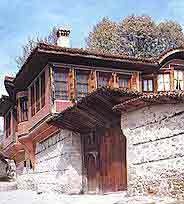|
|
| |
BULGARIA
KOPRIVSHTITZA
One of the most charming small Bulgarian towns, still preserving the atmosphere of the National Re- vival period, is huddled in the mountain folds 111 km east of Sofia. The town is a unique combina- tion of a legendary history and fascinating present. No other Bulga- rian museum town boasts such a large number of houses and mo- numents - 383 in all, most of which have been restored to their original appearance. A unique col- lection of ethnographical treasu- res, old weapons, National Revival works of art, fine fretwork, house- hold weaves and embroidery, na- tional costumes and typical Bul- garian jewelry has also been pre- served. It was here that the first bullet of the April Uprising against the Ottoman oppressors was fired in 1876.
 White stone walls, overgrown with ivy and wild geranium, fence in gardens full of flowers. Vaulted stone bridges run across the bubbly Topolnitsa river. Heavy, iron-studded gates hide blue, yellow and red houses with verandas, bay windows and eaves, and the spacious rooms are lit up by brightly coloured rugs and cushions, carved ceilings and cupboards, copper vessels and ceramics.
Specialists say that every house in Koprivshtitsa is a work of art. The Oslekov, Kableshkov and Lyutov houses are fine examples of this.
The houses dated to the second half of the 19th century have exqusite painted facades and sunny ve- randahs, with carved ceilings and stylish European furnishings.
|
|
|
Festivals and Fairs
The Great Koprivshtitza Folklore Festival
The Great Koprivshtitza Folklore Festival is Bulgaria's largest gathering of traditional musicians and singers and is a cross between a pop festival and a medieval fair. It is a sight that knows no equal: thousands of musicians and singers making the hillside above the picturesque village of Koprivshtitza their home for a few days. Coupled with this you have the colourful stalls of the traders and the thousands of visitors who come for the festival.
This is Bulgarian music as it was always played, played by the ancestors of those who first played it. But perhaps it is what happens on the periphery that is the most authentic. Strolling players or soloists, simply playing for the sheer enjoyment. forming new bonds with other musicians or just letting their music ring out over the hillside.
The Bourgas International Folk Festival
The Bourgas International Folk Festival, held annually, attracts a host of Bulgarian and international artists and is held in the second half of August.
The Kazanluk Festival
The Kazanluk Festival of the Roses is held annually in early June, and has grown from a local to an international event. Not only are the roses, Kazanluk's main industry, in full flower. but the town itself blossoms while visitors enjoy the "Rose Picnic" and all the fun of a folklore festival, with its costumes, songs and dance. Should you still have the energy left, you can always visit the old factories where the rose oil is extracted.
St. Trifon's Day
In the agricultural calendar, St. Trifon's Day celebrates the pruning of the vines, and is held on February 14.
Kukerov Den
On the first Sunday before Lent, Kukerov Den celebrates the start of the agricultural year, and all over Bulgaria you can witness processions led by the dancing. leaping Kukeri dressed in colourful masks and costumes.
Baba Marta
Baba Marta is celebrated on March 1 when peasant house-holds brush out the winter cobwebs with a traditional spring clean. and people offer each other tokens of good luck called martenitsas.
Kukeri
Like western countries. the Bulgarian calendar is dotted with important feast days and festivals. The festival of the Kukeri re-enacts ancient surovaki rites to ward off evil spirits and Kukeri fertility rites. Although only held once every five years, it brings together dancers from all over Bulgaria in a rainbow of colours and styles.
St. Lazarus Day
Lazaruvane is also celebrated in spring on St. Lazarus Day, and here village girls considered fit for marriage perform ritual songs and dances.
St. Konstantin and St. Elena Day
The coming of summer is traditionally celebrated on St. Konstantin and St. Elena Day on May 21, and in some of the remoter villages in the Stranzha hills fire dancing, dancing on heated coals, is still practised in celebration of summer's arrival. Ethnologists have suggested that this practice is directly descended from Dionysina rites of the ancient Thracian.
|